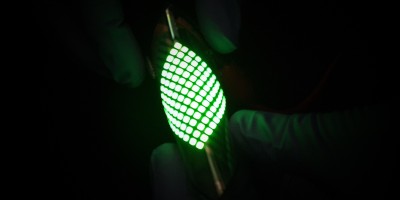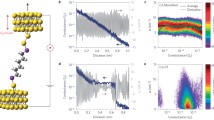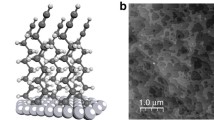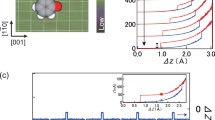Abstract
The transport of charge through a conducting material depends on the intrinsic ability of the material to conduct current and on the charge injection efficiency at the contacts between the conductor and the electrodes carrying current to and from the material1,2,3. According to theoretical considerations4, this concept remains valid down to the limit of single-molecule junctions5. Exploring this limit in experiments requires atomic-scale control of the junction geometry. Here we present a method for probing the current through a single C60 molecule while changing, one by one, the number of atoms in the electrode that are in contact with the molecule. We show quantitatively that the contact geometry has a strong influence on the conductance. We also find a crossover from a regime in which the conductance is limited by charge injection at the contact to a regime in which the conductance is limited by scattering at the molecule. Thus, the concepts of ‘good’ and ‘bad’ contacts, commonly used in macro- and mesoscopic physics, can also be applied at the molecular scale.




Similar content being viewed by others
References
Scott, J. C. Metal–organic interface and charge injection in organic electronic devices. J. Vac. Sci. Technol. A 21, 521–531 (2003).
Nemec, N., Tom´anek, D. & Cuniberti, G. Contact dependence of carrier injection in carbon nanotubes: an ab initio study. Phys. Rev. Lett. 96, 076802 (2006).
Basch, H., Cohen, R. & Ratner, M. A. Interface geometry and molecular junction conductance: geometric fluctuation and stochastic switching. Nano Lett. 5, 1668–1675 (2005).
Xue, Y. & Ratner, M. A. Microscopic study of electrical transport through individual molecules with metallic contacts. ii. effect of the interface structure. Phys. Rev. B 68, 115407 (2003).
Moth-Poulsen, K. & Bjørnholm, T. Molecular electronics with single molecules in solid-state devices. Nature Nanotech. 4, 551–556 (2009).
Ho Choi, S., Kim, B. & Frisbie, C. D. Electrical resistance of long conjugated molecular wires. Science 320, 1482–1486 (2008).
Quek, S. Y. et al. Mechanically controlled binary conductance switching of a single-molecule junction. Nature Nanotech. 4, 230–234 (2009).
Joachim, C., Gimzewski, J. K., Schlittler, R. R. & Chavy, C. Electronic transparence of a single C60 molecule. Phys. Rev. Lett. 74, 2102–2105 (1995).
Schulze, G. et al. Resonant electron heating and molecular phonon cooling in single C60 junctions. Phys. Rev. Lett. 100, 136801 (2008).
Néel, N., Kröger, J., Limot, L. & Berndt, R. Conductance of oriented C60 molecules. Nano Lett. 8, 1291–1295 (2008).
Temirov, R., Lassise, A., Anders, F. B. & Tautz, F. S. Kondo effect by controlled cleavage of a single-molecule contact. Nanotechnology 19, 065401 (2008).
Wang, Y. F. et al. Atomic-scale control of electron transport through single molecules Phys. Rev. Lett. 104, 176802 (2010).
Martin, C. A. et al. Fullerene-based anchoring groups for molecular electronics. J. Am. Chem. Soc. 130, 13198–13199 (2008).
Limot, L., Kroger, J., Berndt, R., Garcia-Lekue, A. & Hofer, W. A. Atom transfer and single-adatom contacts. Phys. Rev. Lett. 94, 126102 (2005).
Repp, J., Meyer, G., Rieder, K.-H. & Hyldgaard, P. Site determination and thermally assisted tunneling in homogenous nucleation. Phys. Rev. Lett. 91, 206102 (2003).
Fölsch, S., Hyldgaard, P., Koch, R. & Ploog, K. H. Quantum confinement in monatomic Cu chains on Cu(111). Phys. Rev. Lett. 92, 056803 (2004).
Schull, G., Frederiksen, T., Brandbyge, M. & Berndt, R. Passing current through touching molecules. Phys. Rev. Lett. 103, 206803 (2009).
Néel, N. et al. Controlled contact to a C60 molecule. Phys. Rev. Lett. 98, 065502 (2007).
Scheer, E. et al. The signature of chemical valence in the electrical conduction through a single-atom contact. Nature 394, 154–157 (1998).
Paulsson, M. & Brandbyge, M. Transmission eigenchannels from nonequilibrium Green's functions. Phys. Rev. B 76, 115117 (2007).
Soler, J. M. et al. The SIESTA method for ab initio order-n materials simulation. J. Phys. Condens. Matter 14, 2745–2779 (2002).
Brandbyge, M., Mozos, J. L., Ordejon, P., Taylor, J. & Stokbro, K. Density-functional method for nonequilibrium electron transport. Phys. Rev. B 65, 165401 (2002).
Acknowledgements
This work was supported by the Deutsche Forschungsgemeinschaft (SFB 677), the Schleswig–Holstein Fonds, the Ministerio de Cienciae Innovacion (FIS2007-6671) and the Basque Department of Education (IT-366-07).
Author information
Authors and Affiliations
Contributions
G.S. and R.B. provided the experimental concept. G.S. performed the STM and contact experiments. T.F. performed the first-principles calculations, and analysis was carried out with A.A. and D.S.P. All authors contibuted to the discussion of the results and preparation of the manuscript.
Corresponding authors
Ethics declarations
Competing interests
The authors declare no competing financial interests.
Supplementary information
Supplementary information
Supplementary information (PDF 889 kb)
Rights and permissions
About this article
Cite this article
Schull, G., Frederiksen, T., Arnau, A. et al. Atomic-scale engineering of electrodes for single-molecule contacts. Nature Nanotech 6, 23–27 (2011). https://doi.org/10.1038/nnano.2010.215
Received:
Accepted:
Published:
Issue Date:
DOI: https://doi.org/10.1038/nnano.2010.215
- Springer Nature Limited
This article is cited by
-
Hot luminescence from single-molecule chromophores electrically and mechanically self-decoupled by tripodal scaffolds
Nature Communications (2023)
-
Navigating with chemometrics and machine learning in chemistry
Artificial Intelligence Review (2023)
-
Artificial-intelligence-driven scanning probe microscopy
Communications Physics (2020)
-
Tuning electrical conductance of molecular junctions via multipath Ru-based metal complex wire
Indian Journal of Physics (2020)
-
Electronic transport in planar atomic-scale structures measured by two-probe scanning tunneling spectroscopy
Nature Communications (2019)





